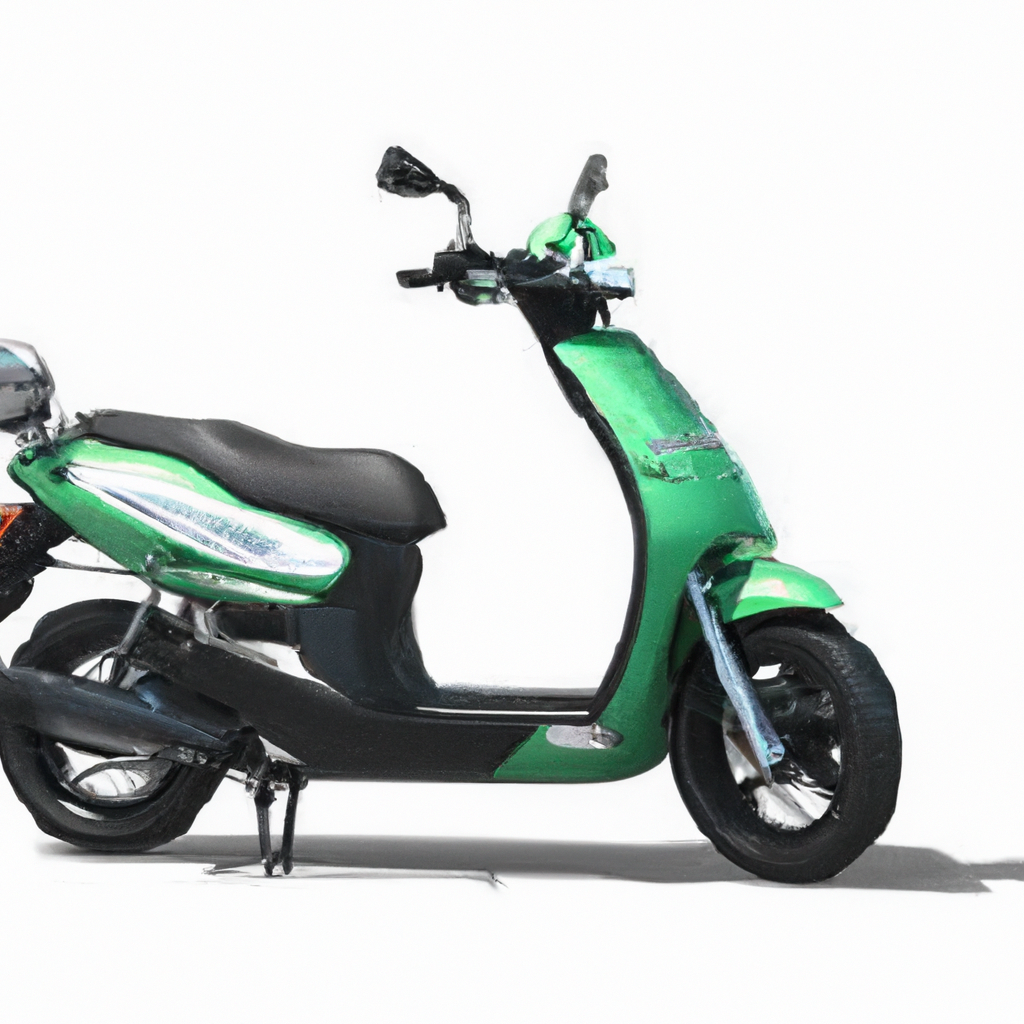So, you’ve probably seen electric scooters zipping around cities lately, providing a convenient and eco-friendly mode of transportation. However, have you ever wondered how these sleek machines actually work? Well, let’s take a closer look at the science behind electric scooters. From their power source to the mechanics involved, understanding the inner workings of these vehicles will not only satisfy your curiosity but also give you a new appreciation for the engineering marvel that they are. So, buckle up (figuratively, of course), as we embark on an electrifying journey to unravel the secrets behind electric scooters.
I. Overview of Electric Scooters
A. Definition of Electric Scooters
Electric scooters are compact, two-wheeled vehicles that are powered by an electric motor instead of a conventional internal combustion engine. They provide a convenient and eco-friendly mode of transportation for short distances.
B. Brief History of Electric Scooters
The history of electric scooters can be traced back to the late 19th century when the first concepts and prototypes began to emerge. However, it was only in the early 21st century that electric scooters gained significant attention and became commercially available.
C. Popularity and Adoption of Electric Scooters
In recent years, electric scooters have witnessed a surge in popularity and adoption, especially in urban areas. Their convenience, low maintenance requirements, and eco-friendly nature have attracted commuters, students, and individuals looking for an alternative to traditional transportation methods.
II. Components of Electric Scooters
A. Electric Motor
The electric motor is the heart of an electric scooter. It converts electrical energy from the battery into mechanical power, propelling the scooter forward. Electric scooters generally use brushless DC motors for their efficiency, low noise, and high torque capabilities.
B. Battery
The battery is the power source for electric scooters and determines their range and performance. Lithium-ion batteries are commonly used due to their high energy density and long lifespan. The capacity of the battery determines how far an electric scooter can travel on a single charge.
C. Controller
The controller acts as the central control unit, regulating the flow of electricity between the battery, motor, and other components. It monitors the input from the throttle, manages the power output, and ensures the scooter operates smoothly and efficiently.
D. Throttle
The throttle, typically located on the handlebars, allows the rider to control the speed of the electric scooter. By manipulating the throttle, riders can increase or decrease the power delivered to the motor, adjusting their speed according to their preferences or the road conditions.
E. Brakes
Electric scooters are equipped with brakes to ensure safe and controlled stopping. Common types of brakes used in electric scooters include mechanical disc brakes and regenerative (electric) brakes. Regenerative braking systems convert kinetic energy into electrical energy, which is then used to recharge the battery.
F. Wheels and Tires
The wheels and tires of an electric scooter play a crucial role in providing stability, traction, and comfort. They are typically made of durable materials to withstand the demands of daily use, and pneumatic (air-filled) tires are often preferred for their shock-absorbing capabilities and improved ride quality.
G. Frame
The frame of an electric scooter houses all its components, providing structural integrity and support. It is usually made of lightweight yet robust materials such as aluminum or carbon fiber, balancing the need for strength and maneuverability.
H. Suspension
Suspension systems on electric scooters help absorb shocks and vibrations, providing a smoother and more comfortable ride. Common types of suspension include front forks, rear spring systems, or a combination of both, depending on the scooter’s design and intended use.
I. Lighting and Safety Features
Electric scooters are equipped with lighting systems to ensure visibility and safety, especially during low-light conditions. This typically includes front headlights, rear taillights, and brake lights. Additional safety features may include reflectors, turn signals, and horn systems.
J. Accessories and Optional Features
Many electric scooters offer a range of accessories and optional features to enhance the user experience. These can include storage compartments, phone mounts, adjustable seating, built-in audio systems, and even GPS tracking capabilities.

III. How Electric Scooters Work
A. Electric Motor Functionality
When the rider engages the throttle, the controller sends a signal to the electric motor, which then starts to spin. The motor’s magnetic fields interact with the electrical currents flowing through its windings, causing the rotor to rotate. This rotational motion is then transferred to the wheels, propelling the scooter forward.
B. Battery Operation and Charging
The battery supplies the required electrical energy to power the electric motor. It stores the energy during charging and releases it when the motor is operational. Electric scooter batteries can be charged by plugging them into a standard electrical outlet or using specialized charging stations.
C. Controller and Throttle Mechanism
The controller acts as the intermediary between the rider’s input through the throttle and the motor’s power output. It interprets the throttle position and adjusts the electrical current sent to the motor accordingly, allowing the rider to control the scooter’s speed.
D. Braking and Regenerative Systems
Electric scooters employ various braking mechanisms to slow down or stop the scooter. Mechanical disc brakes are activated by hand controls, while regenerative braking systems convert the scooter’s kinetic energy into electrical energy, slowing down the scooter and replenishing the battery.
E. Wheel and Tire Mechanics
The rotational motion of the electric motor is transferred to the wheels through a drivetrain, which typically consists of gears, belts, or chains. The tires provide traction and grip, allowing the scooter to remain stable on different surfaces and assist in the overall maneuverability of the vehicle.
F. Frame and Suspension Design
The frame of an electric scooter provides the necessary structure and support for all the components. It is designed to be lightweight yet sturdy, allowing for easy maneuverability and maintaining stability during rides. Suspension systems absorb shocks and vibrations, ensuring a smoother and more comfortable ride.
G. Lighting and Safety Features in Action
During operation, the lighting and safety features of the electric scooter are activated. The headlights and taillights improve visibility for the rider and other road users, while reflectors and turn signals further contribute to safety. These features enable riders to navigate the streets with enhanced visibility and reduce the risk of accidents.
H. Interaction of Components for Optimal Performance
All the components of an electric scooter work in harmony to provide optimal performance. The motor, battery, controller, brakes, wheels, suspension, and other systems interact seamlessly to deliver a reliable and efficient means of transportation. Regular maintenance and proper usage contribute to the longevity and performance of these components.
IV. Advantages of Electric Scooters
A. Environmental Benefits
One of the significant advantages of electric scooters is their positive impact on the environment. Being powered by electricity, they produce zero direct emissions, reducing air pollution and greenhouse gas emissions. Electric scooters contribute to cleaner and healthier urban environments.
B. Cost-Effectiveness and Fuel Savings
Compared to conventional gasoline-powered scooters or cars, electric scooters offer cost-effectiveness and significant fuel savings. Electricity is generally cheaper than gasoline, resulting in lower operating costs. Additionally, electric scooters often require less maintenance and fewer repairs.
C. Versatility and Ease of Use
Electric scooters are versatile and easy to use. They can navigate through congested traffic, narrow streets, and crowded areas with ease, allowing riders to reach their destinations quickly and efficiently. Electric scooters also require minimal effort to operate, making them accessible to a wide range of individuals.
D. Health and Fitness Benefits
Riding an electric scooter can provide health and fitness benefits. While it requires less physical exertion than traditional bicycles, it still offers opportunities for light exercise. Electric scooters can be used as an alternative to sedentary modes of transportation, promoting a more active lifestyle.
E. Noise Reduction and Community Impact
Compared to gasoline-powered scooters or cars, electric scooters are considerably quieter, reducing noise pollution in urban areas. This can have a positive impact on quality of life for both riders and residents, creating a more peaceful and enjoyable community environment.

V. Limitations and Challenges of Electric Scooters
A. Battery Range and Charging Infrastructure
Electric scooters typically have a limited range due to battery capacity, which means they need to be recharged frequently. The availability of charging infrastructure can be a challenge, especially in areas with limited charging stations. Overcoming these limitations requires the development of better battery technology and the expansion of charging networks.
B. Safety Concerns and Accidents
As with any form of transportation, safety concerns exist regarding electric scooters. Accidents can occur due to inexperienced riders, reckless riding, or inadequate infrastructure. Implementing safety measures, such as rider education programs, helmet requirements, and improved infrastructure, is necessary for mitigating these risks.
C. Regulations and Legal Issues
The rapid rise in popularity of electric scooters has led to challenges in implementing regulations and addressing legal issues. Many cities and jurisdictions are working on developing frameworks to govern the operation, parking, and speed limits of electric scooters. Balancing the freedom and convenience of electric scooters with public safety is essential.
D. Maintenance and Durability
While electric scooters generally require less maintenance compared to internal combustion engine vehicles, regular upkeep is still necessary. Components such as tires, brakes, and batteries may need periodic replacements or inspections. Ensuring the durability of electric scooters through proper maintenance contributes to their long-term viability.
E. Effects on Existing Transportation Systems
The integration of electric scooters into existing transportation ecosystems can pose challenges. Sharing limited road space with other vehicles and pedestrians requires careful consideration and planning. Cooperation and collaboration among stakeholders, including city planners, transportation agencies, and scooter operators, are essential to ensure harmonious interactions.
VI. The Science of Battery Technology in Electric Scooters
A. Types of Batteries Used
Electric scooters primarily use lithium-ion batteries due to their high energy density, lightweight nature, and long cycle life. These batteries offer a balance between capacity, weight, and durability, making them ideal for electric scooter applications.
B. Battery Capacity and Energy Density
Battery capacity refers to the amount of electrical energy a battery can store. In electric scooters, batteries with higher capacities offer longer ranges. Energy density refers to the amount of energy a battery can store per unit of volume or weight. Advancements in battery technology aim to increase energy density, allowing for more efficient and compact electric scooter batteries.
C. Charging and Discharging Process
Electric scooter batteries charge when connected to a power source, such as a charging station or a wall outlet. During charging, electrical energy is transferred to the battery, stored as chemical energy. Discharging refers to the process of transferring stored chemical energy back into electrical energy, powering the electric scooter.
D. Battery Management Systems
Battery management systems (BMS) play a crucial role in electric scooter battery performance and longevity. BMS monitors and controls the charging and discharging process, ensuring optimal battery health, preventing overcharging or over-discharging, and balancing the cells to maintain uniform cell voltage.
E. Future Developments in Battery Technology
Ongoing research and development in battery technology aim to improve the performance, safety, and charging times of electric scooter batteries. Advancements in solid-state batteries, fast-charging technologies, and other emerging battery chemistries show promise for future electric scooter applications.

VII. The Role of Electric Motors in Electric Scooters
A. Types of Electric Motors
Electric scooters primarily use brushless DC motors due to their efficiency and reliability. These motors eliminate the need for brushes, resulting in reduced maintenance requirements and increased motor lifespan. Brushless DC motors also provide high torque, allowing for quick acceleration and smooth operation.
B. Electric Motor Power Ratings
Electric motor power ratings refer to the amount of power a motor can deliver. Higher power ratings typically result in faster acceleration and higher top speeds. Electric scooter motors have power ratings ranging from a few hundred watts for lightweight scooters up to several kilowatts for high-performance models.
C. Torque and Performance
Torque is a measure of the twisting force produced by an electric motor. Electric scooter motors designed with high torque capabilities provide quicker acceleration and better hill-climbing ability. The torque characteristics of an electric motor greatly influence the performance and overall ride experience of an electric scooter.
D. Efficiency and Energy Consumption
Efficiency is an important factor in electric scooter motor design. High-efficiency motors convert a greater portion of electrical energy into mechanical power, resulting in longer battery life and extended range. Improving motor efficiency can contribute to increased overall performance and reduced energy consumption.
E. Maintenance and Servicing
Electric scooter motors generally require minimal maintenance compared to internal combustion engines. They do not need oil changes or regular tune-ups. However, periodic inspections to ensure proper functioning of the motor, including checking cables, connectors, and cleanliness, are still recommended for optimal performance.
VIII. Safety Features and Innovations in Electric Scooters
A. Braking Systems and Technologies
Electric scooters incorporate various braking systems to ensure safe and controlled stopping. Mechanical disc brakes are commonly used due to their reliable performance. Some electric scooters also utilize regenerative (electric) brakes, which recharge the battery while slowing down the scooter.
B. Lighting and Visibility Enhancements
Electric scooters are equipped with lighting systems to enhance visibility and safety, especially during low-light conditions. LED headlights, taillights, and brake lights improve the rider’s visibility to others on the road. Reflectors and turn signals further contribute to overall visibility and safety.
C. Stability and Balance Improvements
Stability and balance are crucial for safe and comfortable rides on electric scooters. Some scooters employ wider wheelbases, larger wheels, or improved suspension systems to enhance stability. Additionally, features such as anti-wobble mechanisms and low center-of-gravity designs contribute to better balance and control.
D. Rider Protection and Ergonomics
Safety innovations in electric scooters include rider protection features such as fenders to reduce splashback, non-slip footboards for improved grip, and ergonomic handlebars for comfortable riding positions. These features promote rider safety, reduce fatigue, and contribute to an overall enjoyable riding experience.
E. Anti-Theft Measures
Given their compact size and portability, electric scooters are susceptible to theft. Manufacturers have implemented anti-theft measures such as integrated locks, removable batteries for safekeeping, and smartphone-enabled tracking systems to deter theft and assist in recovery if necessary.

IX. Electric Scooters in Urban Mobility and Sustainable Transportation
A. Role in Reducing Traffic Congestion
Electric scooters play a significant role in reducing traffic congestion in urban areas. Their compact size allows them to navigate through traffic more efficiently than larger vehicles. By encouraging the use of electric scooters for short trips, cities can alleviate traffic congestion and reduce the carbon footprint.
B. Integration with Public Transportation
Electric scooters can complement existing public transportation systems. They provide the first and last-mile connectivity, allowing individuals to easily access public transit stations. Integrating electric scooters with public transportation encourages multimodal transportation, enhancing the overall efficiency and accessibility of urban mobility.
C. Micro-Mobility Solutions and Last-Mile Connectivity
Micro-mobility solutions, including electric scooters, address the challenges associated with transportation over short distances. Electric scooters offer a convenient and sustainable mode of transportation for the last mile, bridging the gap between public transit stations and final destinations, saving time and reducing reliance on cars.
D. Impact on Urban Planning and Infrastructure
The rise of electric scooters has prompted cities to rethink their urban planning and infrastructure. The need for designated parking areas, charging stations, and scooter-friendly infrastructure has become evident. Incorporating electric scooters into urban planning ensures safe and efficient mobility options for all residents.
E. Collaboration with Ride-Sharing and Delivery Platforms
Electric scooters have found a place in the gig economy, with ride-sharing platforms and delivery services utilizing them for efficient and cost-effective transportation. These collaborations provide additional income opportunities for individuals owning electric scooters, while further promoting sustainable transportation practices.
X. Future Prospects and Developments in Electric Scooters
A. Improvement in Battery Technology
Ongoing advancements in battery technology are expected to significantly improve the performance and range of electric scooters. Increased energy density, faster charging times, and longer battery lifespans are among the goals of future battery developments.
B. Enhanced Performance and Range
As electric scooter technology evolves, performance and range are likely to continue improving. Enhanced motors, increased power ratings, and optimized drivetrain systems will result in faster acceleration, improved hill-climbing capability, and longer ranges between charges.
C. Integration of IoT and Connectivity
The integration of Internet of Things (IoT) technology and connectivity features can enhance the functionality and user experience of electric scooters. Connectivity options such as GPS tracking, smartphone apps for remote control and monitoring, and real-time diagnostics can provide users with valuable information and convenience.
D. Advances in Lightweight and Sustainable Materials
The use of lightweight and sustainable materials in electric scooter design will contribute to improved performance and durability. Advances in materials such as aerospace-grade aluminum, carbon fiber, and biodegradable composites can lead to lighter and more eco-friendly electric scooters.
E. Regulatory Framework and Standardization
The rapid growth of the electric scooter industry necessitates the establishment of regulatory frameworks and standardization. Clear guidelines on safety requirements, operational standards, and infrastructure planning are essential to ensure the responsible and sustainable deployment of electric scooters in urban environments.
In conclusion, electric scooters offer a convenient, eco-friendly, and cost-effective mode of transportation. Understanding the components, functionality, and benefits of electric scooters provides insights into their place in urban mobility and their potential for future development. As battery technology continues to evolve, safety features improve, and infrastructure adapts to their integration, electric scooters are poised to revolutionize urban transportation and contribute to more sustainable and accessible cities.




